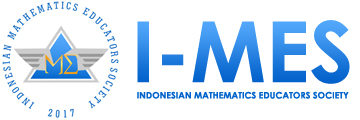Learning Set Theory from Traditional Dance: Ethnomathematics Exploration in Bimanese Traditional Dance Wura Bongi Monca
Abstract
Keywords
Full Text:
PDFReferences
Aikenhead, G. S. (2017). Enhancing school mathematics culturally: A path of reconciliation. Canadian Journal of Science, Mathematics and Technology Education, 17(2), 73-140. https://doi.org/10.1080/14926156.2017.1308043
Aryanti, I. (2023). Bentuk dan makna gerak tari wura bongi monca di kabupaten Bima. Representasi: Jurnal Ilmu Sosial, Seni, Desain dan Media, 2(2), 18-24. https://ejournal.ikreasia.com/index.php/rjissdm/article/view/45/40
Budasi, I. G., Indriani, M. S., & Ana, I. K. T. A. (2022). Lexicons in the wura bongi monca dance in bima district. Proceedings of International Seminar on Translation, Applied Linguistics, Literature, and Cultural Studies, 1(1), 84-92. https://doi.org/10.33633/str.v3i1.7603
D’Ambrosio, U. (2016). An overview of the history of Ethnomathematics. In M. Rosa, U. D’Ambrosio, D. C. Orey, L. Shirley, W. V. Alangui, P. Palhares, & M. E. Gavarrete (Eds.). Current and Future Perspectives of Ethnomathematics as A Program (pp. 5-10). Cham: Springer. https://doi.org/10.1007/978-3-319-30120-4_2
Daryanti, F., & Jazuli, M. (2019). Teaching tradition dance in children building Indonesian characters. In International Conference on Arts and Design Education (ICADE 2018) (pp. 210-213). Atlantis Press. https://doi.org/10.2991/icade-18.2019.48
Fossey, E., Harvey, C., McDermott, F., & Davidson, L. (2002). Understanding and evaluating qualitative research. Australian & New Zealand journal of psychiatry, 36(6), 717-732. https://doi.org/10.1046/j.1440-1614.2002.01100.x
Geofany, M. Y., Budasi, I. G., & Agustini, D. A. E. (2022). An analysis of lexicons related to wura bongi monca dance in bima. Jurnal Pendidikan Bahasa Inggris undiksha, 10(2), 155-163. https://doi.org/10.23887/jpbi.v10i2.57102
Georgios, L. (2018). The transformation of traditional dance from Its first to its second existence: The effectiveness of music-movement education and creative dance in the preservation of our cultural heritage. Journal of Education and Training Studies, 6(1), 104-112. https://doi.org/10.11114/JETS.V6I1.2879
Grossoehme, D. H. (2014). Overview of qualitative research. Journal of Health Care Chaplaincy, 20(3), 109-122. https://doi.org/10.1080/08854726.2014.925660
Ikhwan, I., & Pamungkas, J. (2023). Patterns of asah, asih, nurturing in the implementation of wura bongi monca dance learning. Jurnal Obsesi: Jurnal Pendidikan Anak Usia Dini, 7(3), 3799-3808. https://doi.org/10.31004/obsesi.v7i3.3582
Juwariyah, A., Trisakti, T., & Abida, F. I. N. (2023). Conserving the traditional Indonesian performance art “langen tayub” through “waranggana” creativities. Cogent Arts & Humanities, 10(1), 2247672. https://doi.org/10.1080/23311983.2023.2247672
Oktaviyani, D. M., Utami, N. W., & Utama, G. Y. (2023). Number and set theory in Gamelan: An ethnomathematics study. Jurnal Varidika, 35(2), 110-126. http://dx.doi.org/10.23917/varidika.v35i2.23219
Orey, D. C., & Rosa, M. (2021). Ethnomodelling as a glocalization process of mathematical practices through cultural dynamism. The Mathematics Enthusiast, 18(3), 439-468. https://doi.org/10.54870/1551-3440.1533
Prabowo, H., Patria, R., & Subianto, C. (2022). Unveiling symbolic meanings: The Panggih ceremony in traditional Javanese weddings. Jurnal Ilmu Pendidikan dan Humaniora, 11(2), 102-117. https://doi.org/10.35335/jiph.v11i2.18
Prahmana, R. C. I. (2022). Ethno-Realistic Mathematics Education: The promising learning approach in the city of culture. Springer Nature Social Sciences, 2(12), 1-19. https://doi.org/10.1007/s43545-022-00571-w
Prahmana, R. C. I., & Istiandaru, A. (2021). Learning sets theory using shadow puppet: A study of Javanese ethnomathematics. Mathematics, 9(22), 2938. https://doi.org/10.3390/math9222938
Prahmana, R. C. I., Arnal-Palacián, M., Risdiyanti, I., & Ramadhani, R. (2023). Trivium curriculum in Ethno-RME approach: An impactful insight from ethnomathematics and realistic mathematics education. Jurnal Elemen, 9(1), 298-316. https://doi.org/10.29408/jel.v9i1.7262
Rosa, M., D’Ambrosio, U., Orey, D. C., Shirley, L., Alangui, W. V., Palhares, P., & Gavarrete, M. E. (2016). Current and future perspectives of ethnomathematics as a program (p. 45). Springer Nature. http://dx.doi.org/10.1007/978-3-319-30120-4
Rosala, D., & Budiman, A. (2020). Local wisdom-based dance learning: Teaching characters to children through movements. Mimbar Sekolah Dasar, 7(3), 304-326. https://doi.org/10.17509/mimbar-sd.v7i3.28185
Ruef, J. L., Jacob, M. M., Walker, G. K., & Beavert, V. R. (2020). Why indigenous languages matter for mathematics education: A case study of Ichishkíin. Educational Studies in Mathematics, 104, 313-332. https://doi.org/10.1007/s10649-020-09957-0
Subarinah, S., Junaidi, Triutami, T. W., & Salsabila, N. H. (2023). Implementation of logic and set textbook with ethnomathematics content oriented towards higher-order thinking skills. JTAM (Jurnal Teori dan Aplikasi Matematika), 7(2), 475-488. https://doi.org/10.31764/jtam.v7i2.13509
Wang, Y., & Liu, Q. (2020). Effects of game-based teaching on primary students' dance learning: The application of the personal active choreographer. International Journal of Game-Based Learning (IJGBL), 10(1), 19-36. http://doi.org/10.4018/IJGBL.2020010102
Refbacks
- There are currently no refbacks.

This work is licensed under a Creative Commons Attribution-NonCommercial-ShareAlike 4.0 International License.
Indonesian Journal of Ethnomathematics
Indonesian Mathematics Educators Society
Jl. Terusan Jend. Sudirman, Kec. Cimahi Tengah, Kota Cimahi, Jawa Barat 40521
E-mail: [email protected]
ISSN: 2775-8001


